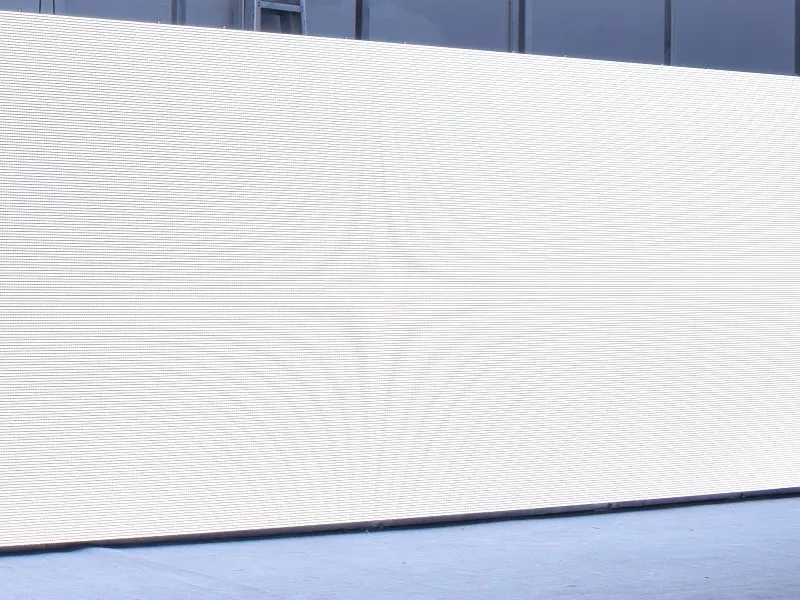Did you ever notice wavy lines on LED screens? If yes, you may encounter moire effect. It can disrupt the visual experience. In this article, we will discuss what moire effect LED screen is, and how to avoid it.
What is the Moire Effect on an LED Screen?
The moire effect on LED screens is a visual phenomenon when two repetitive patterns overlap. It usually happens when the screen’s pixel grid interacts with the pattern of a camera sensor or another similar grid. The result is a wavy pattern. It can be frustrating, especially when you are striving for crisp and clear visuals.

How Does the Moire Effect Occur on an LED Screen?
The moire effect on LED screens is caused by several factors. Here are the main causes:
- Pixel Pitch and Resolution Mismatch: This is one of the most common causes. It is a mismatch between the pixel pitch of the LED screen and the resolution of the capturing device, such as a camera. When the pixel grid of the LED display doesn’t align well with the camera’s sensor grid, it can cause an interference pattern that results in the moire effect.
- Viewing Angle: The angle at which you view the LED screen is another cause. If the angle makes the screen’s pixel grid line up with another grid-like pattern, such as a camera’s sensor lines, it can create moire patterns.
- Content Patterns: Except from the above, another reason of moire effect can be the content shown on the LED screen. If the content has fine, repeating patterns like stripes, grids, or small text, it can clash with the screen’s pixels. And it can create moire.
- Camera Zoom and Focus: The camera’s zoom and focus can also cause the moire effect. When you zoom in on an LED screen, the pixels become more noticeable. It can create moire patterns. Likewise, if the camera isn’t focused properly on the screen, the mismatch between the pixels and the camera’s sensor can lead to moire.

How Does the Moire Pattern Impact LED Screens?
The moire pattern can significantly impact the quality and effectiveness of LED screens. Here’s how:
- Visual Distraction: The wavy lines caused by the moire effect are visually distracting. They can distract attention away from the actual content. As a result, the impact of your message will reduce. It is especially a problem where clarity is crucial, such as retail displays, broadcast studios, etc.
- Reduced Image Quality: The presence of moire patterns lowers the overall image quality on the screen. Instead of sharp, clean visuals, you get distorted images that look unclear. This can be frustrating for both the viewer and the content creator.
- Compromised Professionalism: For businesses, a screen with moire patterns can bring a bad impression. Whether it’s during a live event or on a broadcast, the moire effect can make your display look faulty or poorly managed, which can affect your brand’s reputation.

How to Reduce the Moire Effect on an LED Screen?
Reducing the moire effect from an LED screen can be challenging. However, there are several effective strategies you can use. Here’s some advice:
- Adjust the Viewing Angle: Sometimes, a simple change in the viewing angle can reduce or eliminate the moire effect. By slightly shifting the camera angle or the screen’s position, you can minimize the pattern interference. Although this method often involves some trial, it’s one of the quickest fixes.
- Change the Pixel Pitch: If possible, use an LED screen with a different pixel pitch. The pixel pitch is the distance between the centers of two adjacent pixels. By selecting a screen with a finer or coarser pitch, you can prevent the pixel grid from clashing with other patterns. Thus, it can reduce the moire effect.
- Use a Low-Pass Filter on the Camera: Adding a low-pass filter to your camera can help blur the fine details. This filter softens high-frequency details. So, it is unlikely for the camera’s sensor to pick up the unwanted patterns. Although it may slightly reduce image sharpness, it’s a useful way to avoid moire.
- Adjust the Camera’s Focus and Zoom: Carefully adjusting the camera’s focus and zoom can also help. A small change in the zoom level or refocusing the camera can reduce the moire effect.
- Modify the Content: If the moire effect is caused by the content itself, you can consider altering the design. Avoid using fine, repetitive patterns like stripes, grids, or small text. Instead, use simpler designs or larger patterns that won’t clash with the screen’s pixel grid.
- Post-Processing: For recorded content, software can help reduce the moire effect during post-production. This is particularly useful for videos or images that have already been captured and are showing signs of moire.

Conclusion:
After reading this article, I hope you can get some idea about how to reduce the moire effect on LED screens.
If you are interested in knowing more about LED screens, please contact us.


